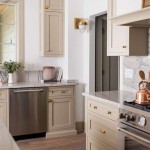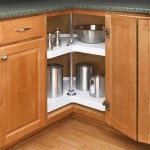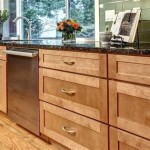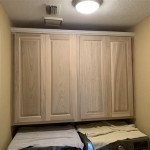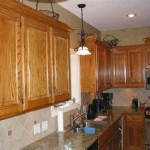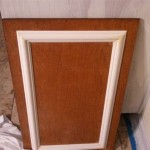How To Make Shaker Cabinet Doors With a Router Table
Shaker cabinet doors, renowned for their simplicity and clean lines, are a staple in modern and traditional kitchens and bathrooms. Constructing these doors requires precision and accuracy to achieve a professional, aesthetically pleasing result. A router table, with its ability to provide a stable and controlled platform, is an invaluable tool for shaping the profiles and creating the necessary joinery for these doors. This article provides a detailed guide on crafting Shaker cabinet doors utilizing a router table.
The process involves selecting appropriate lumber, milling the components to consistent dimensions, utilizing specific router bits to create the desired profiles and joinery, assembling the door frame, and finally, inserting the panel. Each step requires careful attention to detail to ensure a successful and high-quality finished product.
Selecting Materials and Preparing Lumber
The initial step in crafting Shaker cabinet doors involves selecting suitable lumber. Hardwoods such as maple, cherry, oak, and poplar are commonly used due to their durability, stability, and ability to accept paint or stain evenly. Softwoods like pine can be used, but they are generally less durable and more prone to denting.
Once the lumber is chosen, it must be properly milled to consistent dimensions. This typically involves using a jointer to create one perfectly flat face and one square edge. Subsequently, the lumber is passed through a planer to achieve a consistent thickness. The final width of the stiles and rails is then achieved using a table saw. Accuracy in these milling operations is critical for ensuring tight-fitting joints and a professional appearance. A typical dimension for stiles and rails is between 2 ¼ inches and 3 inches in width, while the thickness is commonly ¾ inch.
The panel material can be either solid wood or plywood. Solid wood panels require additional considerations for wood movement, typically achieved by using a floating panel design. Plywood, such as birch or maple plywood, offers greater stability and is less susceptible to expansion and contraction due to changes in humidity. The panel thickness is generally ¼ inch to allow it to fit within the groove created in the stiles and rails. Preparing the panel involves cutting it to the appropriate size, leaving a slight margin for fitting within the assembled frame.
Routing Profiles and Joinery
The router table is the centerpiece of this process, enabling the creation of the profiles on the stiles and rails and the joinery that connects them. A variety of router bits are used to achieve the desired effect. Common bits include cope and stick sets, which create both the profile on the inside edge of the stiles and rails and the mortise and tenon or tongue and groove joint that connects them.
When using a cope and stick set, the 'stick' bit is used first to create the decorative profile on the inside edge of the stiles and rails. The router table fence is adjusted to ensure the bit removes the correct amount of material, creating a consistent profile along the entire length of the workpiece. Multiple passes may be required to achieve the desired depth of cut, particularly with hardwoods. It is crucial to maintain a steady feed rate and apply even pressure to prevent tear-out and ensure a smooth, consistent profile.
The 'cope' bit is then used to create the matching profile and the tenon (or tongue) on the ends of the rails. This bit is designed to create a perfect fit with the profile created by the stick bit, ensuring a seamless transition between the stiles and rails. The height of the bit and the position of the fence are critical for achieving a tight-fitting joint. Test cuts on scrap material are essential to fine-tune the setup before routing the actual rails.
Alternative joinery methods, such as mortise and tenon joints created with separate router bits, can also be used. This approach requires careful setup and precise routing to ensure accurate and strong joints. A mortising jig or a dedicated tenoning jig can significantly improve accuracy and efficiency when using this method.
Regardless of the joinery method chosen, it is critical to ensure that the router bits are sharp and well-maintained. Dull bits can cause tear-out, burning, and uneven cuts, compromising the quality of the finished door.
Assembling the Door Frame and Inserting the Panel
Once the stiles, rails, and panel are prepared, the door frame can be assembled. Dry-fitting the components is essential to ensure a proper fit and identify any potential issues before applying glue. Any necessary adjustments can be made at this stage.
When satisfied with the fit, glue is applied to the tenons (or tongues) and the mortises (or grooves). The frame is then assembled and clamped tightly, ensuring that all joints are square and flush. Corner clamps or pipe clamps are commonly used to apply even pressure and maintain alignment during the glue-up process.
The panel is then inserted into the groove created in the stiles and rails. If using a solid wood panel, it is critical to allow for wood movement by not gluing the panel in place. Small rubber spacers or space balls can be used to center the panel within the frame while allowing it to expand and contract with changes in humidity. This prevents the panel from splitting or warping the frame.
If using a plywood panel, it can be lightly glued in place, as plywood is more dimensionally stable. However, it is still advisable to leave a small gap to accommodate any minor movement.
After the glue has dried completely, the clamps can be removed. The frame is then inspected for any imperfections or misalignments. Minor gaps or imperfections can be filled with wood filler and sanded smooth. The entire door is then sanded to prepare it for finishing.
The finishing process involves applying a stain or paint to achieve the desired color and protective coating. Multiple coats of finish may be required, with light sanding between coats, to achieve a smooth and durable surface. Choosing the appropriate finish depends on the type of wood, the desired aesthetic, and the intended use of the cabinet door. For high-moisture environments, such as bathrooms, a water-resistant finish is recommended.
Creating Shaker cabinet doors using a router table requires a systematic approach, careful attention to detail, and the use of appropriate tools and techniques. By following these guidelines, it is possible to produce high-quality, professional-looking cabinet doors that will enhance the appearance and functionality of any kitchen or bathroom.
Proper setup is crucial for success. A precise and well-maintained router table is essential for consistent and accurate results. Invest in quality router bits specifically designed for cabinet door construction. Practice on scrap wood to hone skills and fine-tune setups before working with the final materials. Safety precautions, including wearing safety glasses and hearing protection, are paramount when operating power tools. A well-ventilated workspace is also important for minimizing exposure to dust and fumes.
Mastering the art of Shaker cabinet door construction with a router table empowers woodworkers to create custom cabinetry that reflects personal style and enhances the value of their homes. With patience, practice, and attention to detail, anyone can achieve professional-quality results.
Finally, the choice of wood species, finish, and hardware can dramatically impact the overall aesthetic of the Shaker cabinet doors. Experiment with different combinations to find the perfect balance that complements the surrounding décor. Consider using contrasting wood species for the frame and panel to create a visual focal point. Explore various hardware options, such as knobs, pulls, and hinges, to add a personalized touch. With careful planning and execution, the possibilities are endless.

Make Cabinet Doors With A Router Free Project Plan

Making Drawer Fronts On A Router Table Kreg Tool

The Easiest Way To Diy Shaker Cabinet Doors Fun Home Building

How To Make A Diy Cabinet Door With The Router Tutorial Free

Easy Cabinet Doors Made On The Router Table 6 Steps With Pictures Instructables

Never Using A Table Saw For This Again Shaker Style Cabinet Doors With Router

Make Cabinet Doors With A Router Free Project Plan

Easy Cabinet Doors Made On The Router Table 6 Steps With Pictures Instructables

Diy Shaker Cabinet Doors Montreal

Make Mission Or Shaker Style Doors With Tongue Groove Router Bit Set Infinity Cutting Tools
Related Posts

